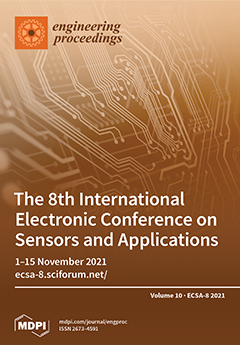Cylindrical structure analysis is important in several areas and can be performed through the evaluation of the diameter changes of these structures. Two important areas can be mentioned: pipelines for oil or gas distribution and the condition and growth of trees. In the tree diameter changes, monitoring is directly related to irrigation, since it depends on the water soil deficit and trees are important in the global circulation of heat and water. This diameter can change in the order of 5 mm for some species. In this paper, a strain gauge sensor based on a core diameter mismatch technique for diameter measurement is proposed and investigated. The sensor structure is formed by splicing an uncoated short section of MMF (Multimode Fiber) between two standard SMFs (Singlemode Fiber) called SMF–MMF–SMF (SMS); the MMF length is 15 mm. Two cylindrical structures were placed on a 3D printer, with different diameter sizes (
: 80 mm and 110 mm), to assist in monitoring the diameter changes. The SMS sensor was placed on the printed structure and fixed at two points, such that, by reducing the diameter of the structure, the sensor presents dips or peaks shift of the transmittance spectrum due to the induced curvature and strain. Three values were used for the spacing between the fixation points (
): (a) 5 mm, (b) 10 mm, and (c) 15 mm. For each choice of fixation points,
= 80 mm: (a) a sensitivity of −0.876 nm/mm,
of 0.9909 and a dynamic range of 5 mm; (b) a sensitivity of −0.3892 nm/mm,
of 0.9954 and a dynamic range of 4 mm; and (c) a sensitivity of −0.768 nm/mm,
of 0.9811 and a dynamic range of 2 mm. For
= 110 mm, the sensor presents for each choice of fixation points: (a) a sensitivity of −0.22 nm/mm,
of 0.9979 and a dynamic range of 8 mm; (b) a sensitivity of −0.2284 nm/mm,
of 0.9888 and a dynamic range of 6 mm; and (c) a sensitivity of −0.691 nm/mm,
of 0.9892 and a dynamic range of 3.5 mm.
Full article




